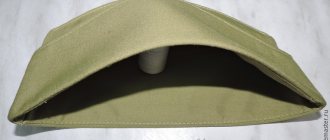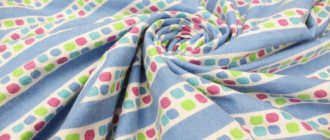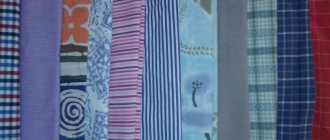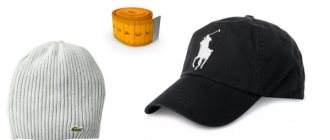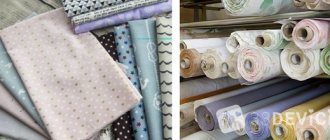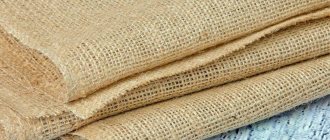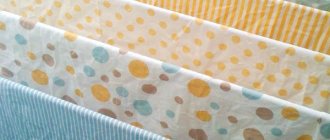How to determine the type of fabric by appearance and touch
If the price tag in a store says “linen,” this does not mean at all that what you see is really linen. It is quite possible that this is pure synthetics, imitating linen. And the inscription “cashmere” does not guarantee the presence of wool in the fabric. Fabric manufacturers have learned to pass off synthetics as linen, viscose as wool... Therefore, as they say, trust, but verify.
The most accurate way to check the type of fiber is by combustion test. But you won’t burn fabric in a store, so it’s important to be able to determine the fibrous composition of the material by appearance, touch, and crush test.
When examining the fabric, pay attention to the thickness, smoothness and shine of the threads, and the rigidity - the plasticity of the fabric. And listen to the sensations that arise when you touch the fabric.
To test for creasing, squeeze the fabric into a fist for 30 seconds, then release and smooth it with your hand. The nature of the folds will help determine the composition of the fabric.
Fabrics made from cotton fibers
Fabrics made from cotton fibers are warm to the touch, slightly rough, and dry. Their touch on the body is comfortable.
Fabrics made from long-staple cotton (such as cotton cambric) are thinner and smoother, so they may have a silky feel, but the silkiness is subtle and not at all like staple fabrics.
Cotton fabrics wrinkle heavily, and after smoothing them with your hand, the folds do not disappear. The addition of synthetics reduces wrinkling.
PS New cotton fabrics often have stiffness, smoothness and even a slight shine due to the sizing applied to them, which is washed off during washing.
Fabrics made from linen fibers
Fabrics made from linen fibers look and feel similar to cotton, but are a little stiffer and cooler.
Linen threads are often uneven in thickness, i.e. have thickenings in certain areas. Also, linen yarn may have a slight shine due to the special faceted shape of the flax fibers.
Linen fabrics do not dye well, so they are characterized by dull colors: blue, light green, pale yellow... If linen fabric is bright in color, then there are additives of other fibers. It is even possible that there is no flax at all.
Linen fabrics wrinkle heavily, the resulting folds are very stable and difficult to smooth out not only with your hand, but also with an iron. Therefore, synthetics are introduced into linen fabrics.
If cotton or viscose is added to linen, the fabric wrinkles just as much, but smoothes out more easily.
Natural silk fabrics
Very pleasant and soft to the touch, have a soft deep shine, not like the harsh shine of fabrics made from chemical fibers.
Fabrics made from crepe silk threads (crepe de Chine) are rough due to a special type of thread twist, the shine is very restrained, but still noticeable.
Thin fabrics made from natural silk are almost weightless and can be threaded through a wedding ring. I checked, I succeeded, although it seemed impossible.
Undyed fabrics in a pleasant creamy shade.
Fabrics made from natural silk do not wrinkle much; the folds gradually disappear when smoothed by hand.
Fabrics made from wool fibers
Fabrics made from wool fibers give a feeling of warmth and scratchiness. It is not always possible to catch the prickliness with your palm, so you can touch the fabric with a more delicate place, for example, the cheek or neck.
Woolen fabrics are woolly, because the tips of wool fibers stick out on the surface. There may be more or less of them depending on the density and weave of the fabric, as well as the type of fiber used (fine, semi-fine, coarse, semi-coarse wool).
Due to the fluffiness of wool yarn, wool fabrics are matte without shine. Shine appears when improperly ironed and intensive wear on places that experience constant friction (elbows, knees...)
On pure wool fabrics, when wrinkled, soft folds form, which disappear when smoothed by hand.
On woolen fabrics with the addition of plant fibers, large raised folds are formed that do not disappear when smoothed by hand.
On woolen fabrics with the addition of synthetics, large layers are formed that disappear when smoothed by hand.
Fabrics made from artificial fibers
Fabrics made from artificial threads feel harsh and cold to the touch. The shine is sharp, cold, synthetic.
Fabrics made from staple yarn are similar in appearance and feel to cotton, but smoother and silkier. They wrinkle very badly, and when smoothed by hand, the folds do not disappear.
Read more about the staple here
Fabrics made from synthetic threads
The modern textile industry is developing and constantly offers new types of fibers, threads, yarns, weaves, and fabric finishing, so fabrics made from synthetic threads are very diverse in appearance. They can be either clearly synthetic or imitate natural ones.
The shine of smooth synthetic fabrics is sharper than that of natural silk.
Synthetic fabrics resist wrinkles well. The resulting wrinkles are smoothed out well.
To the touch, synthetic fabrics seem to be “detached”, i.e. less pleasant and colder than natural ones. But this is sometimes such an elusive nuance that is accessible only to those who work a lot with fabrics.
The only sure way to determine whether a fabric is synthetic or not is to conduct a burn test. When synthetics burn, melting always occurs.
Train your ability to feel fabrics. This is a very useful skill, especially for those who sew, because... allows you to predict the behavior of the fabric during sewing and wearing, and therefore prevent possible troubles.
DO YOU THINK THIS WOULD BE USEFUL FOR YOUR FRIENDS? SHARE WITH THEM ON SOCIAL NETWORKS!
How to identify fabric
The modern textile industry produces hundreds of types of fabrics. Their ingenious machines weave day and night, and natural and artificial materials appear on store shelves, coming from the field - warmed by the sun, blown by the wind, and from the depths of chemical plants - products of high pressure and organic synthesis. They all serve their purposes, but sometimes there is a need to determine what kind of fabric we are holding in our hands - natural or artificial, silk, wool or nylon. But how can we identify the fabric if we do not have at our disposal a chemical laboratory with flasks and retorts and an attentive, strict female laboratory assistant in a snow-white coat? Yes, very easy and simple!
The fact is that for the initial determination of tissue no laboratory is needed, and all necessary studies require the simplest instruments and are carried out on the fly. Let's try to figure out how to identify fabric, having only a source of open fire and our own sensations.
So, we have a sample of some fabric. First of all, it is not always possible to determine “by sight and touch” whether a fabric is natural, artificial or mixed. It is especially difficult to distinguish between natural and artificial silk. However, we have the opportunity to use a method that has been used literally since ancient times to identify tissues. This method is a fire test, otherwise it is a combustion test.
How to identify fabric using a simple burn test?
So, let's set fire to the fabric (of course, you need a small sample for the experiment). Fabric based on natural materials (linen, cotton) burns quite quickly. If the sample is extinguished by blowing on it, the flame will quickly go out, but the burnt fibers will smolder and glow for some time. Burnt fabric leaves a smell of burnt cellulose (this smell can be smelled if you set fire to cotton wool or paper).
Wool and natural silk curl into brittle balls when burned. These materials burn at a low rate and often stop burning if the flame is removed. When burned, wool and silk emit a pungent smell of burnt feathers.
When artificial silk burns, it emits the smell of burnt cellulose or scorched plastic. At the same time, it does not have the characteristic property of natural silk, namely, it cannot quickly acquire body temperature if it is pressed against you.
Acetate fabrics are easily set on fire; when burned, a brown porous ebullient ball is obtained at the end of the thread, which instantly hardens if the fabric is extinguished.
Polyamide fiber (nylon and its varieties, nylon) also lights up quite quickly, releasing strong soot when burning. A ball forms at the end of the thread, similar to acetate fabrics, only it is denser.
When burned, polyester fiber (lavsan and its varieties, terylene) forms a black ball at the end of the thread, and soot is actively released.
When artificial fabric burns, as a rule, you feel very sharp, pungent odors - this is due to the peculiarities of the composition of these fabrics. Also, if you set fire to a fairly large sample of artificial fabric, then molten material collects in the combustion zone and drips down, continuing to burn, which can pose a fire hazard.
Of course, only chemical analysis (which, by the way, is not so difficult to carry out) will help to more accurately determine the tissue. However, at this stage we have become acquainted with a completely accessible method that allows us to quickly determine the origin of the fabric, its type, fiber composition - and we don’t need anything more.
How to determine the composition of fabric at home
Laboratory specialists are usually ready to answer what fibers this or that material is based on. They perform various tests on tissue samples. However, there are at least two methods for determining the composition of fabric, which can be done independently, without resorting to the services of technologists. It's about the tactile way and the burning experience.
To begin with, let us note that canvases today come in two types:
- homogeneous - when the warp and weft fibers have the same composition;
- mixed - when the main and additional threads differ in composition.
The tactile method is suitable for homogeneous fabrics. It is enough to touch them and understand what characteristics the surface of the material has. For clarity, here is a small table.
| Fabric name | Characteristics |
| Linen | It is distinguished by its subtlety. At the same time, the material is quite dense. Its surface can be either smooth or slightly rough. |
| Cotton | This is soft fabric. Upon contact with the hand, it quickly assumes body temperature. |
| Silk | Smooth, soft, sliding material. |
| Wool | Thick fabric. Small hard fibers are allowed on its surface. When palpated, they cause tingling sensations. |
| Nylon | The structure resembles silk, but is denser. |
How to determine the composition of fabric by combustion
Combustion experiments are carried out with both homogeneous and mixed fabrics. It is enough to take a few fibers of the material, set them on fire and monitor the reaction of the threads. Here's another table.
| Fabric name | Reaction of material upon combustion |
| Cotton, linen | The fibers emit a smell similar to burning paper. In this case, the filaments emit light white smoke. At the end of combustion, the sample turns into ash. |
| Viscose | During combustion, it produces virtually no flame. As a result, it turns into gray ash. |
| Silk | The fiber burns slowly without emitting smoke. It smells like burnt hair. The final product is a black soft ball. When pressed with a finger, it is easily crushed. |
| Wool | Burns slowly. In the process, it emits black smoke and an odor reminiscent of burning feathers. Later it turns into small balls. |
| Acetate | Burns quickly, producing black smoke. The process produces a vinegar smell. |
| Nylon, Polyamide | When a flame hits the fibers, they do not burn, but begin to melt. The smell is associated with celery. |
| Polyester | The combustion process is very fast. During it, black smoke with a barely sweet aroma is formed. Subsequently, solid droplets are obtained from the fibers. |
| Acrylic | Burns quickly. Flames sparkling. The fibers emit dark smoke and a fishy odor. Subsequently, the threads turn into solid balls, shaped like drops. |
#useful content
